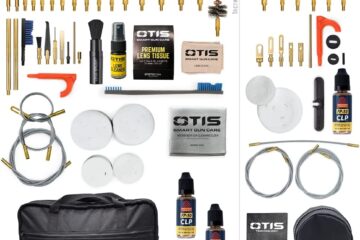Bow hunting is not for the feint of heart, the impatient or the novice. It takes guile, determination, skill and a keen sense of awareness. You’ve got to get in much closer with a bow than you do with a rifle. And once you have your quarry in sight you need to make every shot count. The broadhead was invented to compensate for the innate shortcomings of the standard arrowhead and to reduce the number of wounded animals wandering the backcountry.
When wielded by skilled hands the best will bring down an elk with little trouble. But finding the best broadhead isn’t always easy. There are hundreds on the market today but only a fraction of them could be considered state-of-the-art. Not to worry, however. We’ve scoured the broadhead landscape for you to compile this list of the 10 best broadheads.
1. Grim Reaper X-Bow Mechanical Broadhead Razor Cut
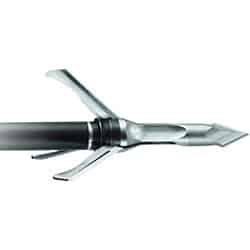
The Grim Reaper X-Bow is crafted from corrosion resistant stainless steel and features a cut on contact tip that’s no match for the thickest skin. This 100 grain broadhead has 3 mechanical blades that swing open on contact to inflict maximum damage. The spring loaded blades feature a minimal number of moving parts. And that’s what we like to see.
Because the more moving parts the more things that could go wrong. The X-Bow is stable out to 100 yards at 400 fps and the 3 stainless steel blades are replaceable. Even if your target moves away after contact the X-Bow Mechanical Razor Cut is going to leave a substantial trail of blood. So tracking them to their resting place should be easy and fast. Made for crossbows but will work equally well on a recurve.
2. Wasp Jak X Mechanical Broadhead
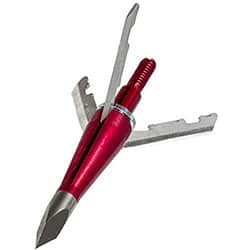
The Wasp Jak X Mechanical Broadhead features a stainless steel trocar tip and 3 steel blades that stay folded forward until contact. Those retractable blades are razor sharp and held fast during flight by a pair of rugged O-rings. Upon contact with flesh the blades are forced back, popping the O-rings in the process and ensuring a wide, fatal incursion into your quarry.
The Jak X is a 100 grain broadhead with a ferrule of aircraft grade aluminum that won’t rust on you. The blades themselves are replaceable but be aware they can cause some non-traditional flight characteristics. So it’s best to get a feel for them at the range before taking them into the field. Normally we might take a pass on such a design. But if you can deliver this puppy to the target accurately it’s going to produce almost unprecedented damage.
3. Wasp Drone Broadhead

The Drone features a sleek, no-nonsense design that flies through the air with the greatest of ease and delivers its 3 razor sharp blades with painful authority. The edges of the 3-sided chisel tip line up with the edges of the blades, providing aerodynamic benefits and ensuring optimal penetration. This particular Drone is 100 grains. But there’s a 125 grain model available if elk are on your itinerary. Overall width is a less than overwhelming 1 1/8 inches.
But because of the efficacy of the design the diameter is not a drawback. If there is a drawback it’s that the design precludes the blades being replaceable. Fortunately, they’re not so expensive that that should be a major issue. And when you see the way they punch through bone you’ll forgive them any shortcomings.
4. Grim Reaper Hades Fixed Blade Broadhead
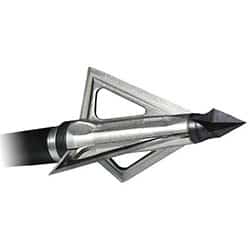
The Hades from Grim Reaper is a 100 grain broadhead that’s ideal for whitetail. It features a chisel tip with 3 incredibly sharp blades. Those blades feature sharpened edges from end to end which makes it almost as easy to remove the arrow as it is to place it.
The ferrule is crafted from aircraft grade aluminum that will stand up to the rigors of the outdoors without rusting away. The tip is a relatively modest 1 3/16 inch in diameter. But the degree of penetrative ability makes up for some of its lack of girth. Like the Drone the blades here are not replaceable. So you’ll want to keep that in mind. But the broadhead has fundamentally dependable flight characteristics and at at 50 yards or less packs a significant punch.
5. Muzzy Trocar Broadhead
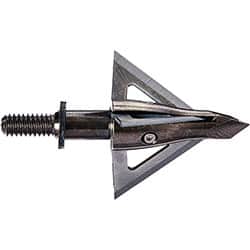
The Muzzy Trocar Broadhead has 3 razor sharp blades arranged into a helix pattern that cause the arrow to spin during flight. This helps it maintain stability and ensures an accurate strike. The ferrule is cold-forged steel topped with a solid steel chisel tip. Together they’re an irresistible force that will punch through bone, delivering a lethal blow.
The blades are replaceable and don’t require a degree in engineering to swap out. And though the diameter is an unremarkable 1 3/16 inch the spinning motion creates a swath of damage that exceeds expectations. If there’s a downside it’s that the cold-forged ferrule may not survive a direct shoulderblade strike.
6. Muzzy MX-3 Broadhead
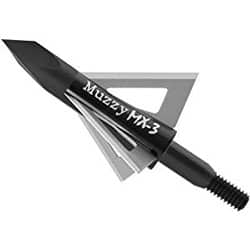
Muzzy makes a follow-up appearance on our list with their excellent MX-3 Broadhead. We’re not alone in feeling that the MX-3 is superior to the newer MX-4. And having used both we’re quite content to stick with this model as long as Muzzy keeps making it. The MX-3 features a chisel tip atop an aircraft grade aluminum ferrule and 3 dangerously sharp replaceable blades.
It’s also available in 75, 100 and 125 grain. So there’s one for every target. The 1 1/4 inch diameter isn’t going to impress larger animals at the 75 grain level. But at 125 grain it takes on a ferocity that belies is trim nature. All in all it’s well crafted, stable (thanks to the offset blades) and effective. With the affordable price being the cherry on the cake.
7. G5 Outdoors Montec Carbon Steel Broadhead
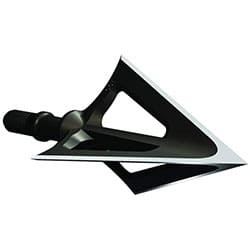
If you’re into clean design you’re probably going to appreciate the G5 Outdoors Montec. It features 3 fixed blades that are sharpened end to end to optimize damage and that’s about it. There are no moving parts to misfire, no O-rings to worry about and because of the affordable price if you break one it’s not the end of the world.
These broadheads are 100 grain and 1 1/8 inch in diameter. Which makes them a solid choice for whitetail but too small for elk or moose. If you’re the gambling type you can try them on something big. But don’t be disappointed when it scurries off leaving only a minimal blood trail to follow. So why are they on our list? Because they’re a dependable, affordable, effective broadhead for mid-sized game.
8. QAD Exodus Full Blade Broadhead
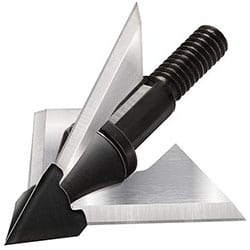
While QAD markets their Exodus as a crossbow broadhead it’s going to serve you well no matter what type of bow you’re using. What sets this broadhead apart from much of the competition are the incredibly fat blades. At 0.4 inches they’re going to announce their arrive with an unmistakable authority.
If you opt for the 125 grain Exodus this broadhead will punch through just about anything in its path and produce a blood trail the size of the Mississippi. The blades are also replaceable and snuggle in securely behind the cut on contact head. Because of the insistent nature of the blades we can overlook the fact that they’re fashioned from fairly low grade steel.
9. Stinger Buzzcut 2 Blade Broadhead
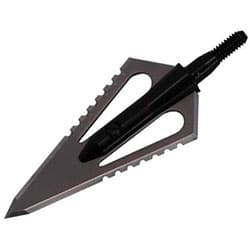
The Buzzcut from Stinger features dual stainless steel blades with serrated edges that slice through tissue like a hot knife through butter. The ferrule is fashioned from aircraft grade aluminum which, like the stainless steel blades, won’t easily succumb to the damp forest environment. At 125 grains they’re hefty enough to take on the bigger beasts.
But with 2 blades instead of 3 or 4 and with a narrow 1 1/4 inch diameter they’re probably not moose material. The only other downside here is that the serrated edge may draw the ire of the regulatory powers that be in your state. So check before buying.
10. Swhacker 100 Grain Mechanical Broadhead
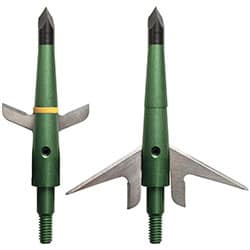
Our final broadhead is the Swhacker 100 Grain Mechanical Broadhead. It features an innovative design that opens inside the animal. The blades have a shorter component that is exposed upon contact. But once penetration has commenced that shorter segment swivels back pulling the 2 inch edge out as it does.
This means greater penetration, fewer broken blades, fewer dull blades and more efficient take downs. The 100 grain weight provides enough authority to punch through the toughest tissue and smaller bone. And the aircraft grade aluminum and stainless steel means they’ll stand up to to damp conditions.
FAQs
What is a Broadhead?
The broadhead is a type of arrowhead (1). While it’s exact origins are shrouded in controversy and myth it’s generally thought to have first gained traction during the medieval period in Europe as a way for archers to inflict maximum damage on opponents. The typical broadhead has 2 or 4 very sharp blades designed to create maximum blood loss in the target.
Ideally the broadhead would cut cleanly through a major blood vessel, causing the person to bleed out quickly. In addition, their design was also intended to produce maximum tissue damage both upon entry and while being removed. Today, broadheads are no longer used for warfare but have become quite popular among hunters. There are several different types of broadheads which we’ll get into now.
What are the Different Types of Broadheads?
As we mentioned there are several types of broadhead tips. Each has its advantages and disadvantages. You’ll find plenty of hunters to support the notion that each is the best type. Although a recent study suggests that mechanical broadheads produce a slightly higher kill rate (2). Still, deciding which of these is the right one for you will largely be a matter of personal preference. That said, let’s look at the different types of broadheads.
- Fixed – Let’s start with the classic. The broadhead can trace its lineage back to medieval Europe when feudalism was the order of the day and city-states were constantly at war with one another. But you’ll find plenty of different opinions about who invented the broadhead tip and when. For the sake of brevity let’s just stick with the medieval period as being when broadhead arrows first came to prominence and leave it at that. That said, the fixed broadhead can feature 2, 3 or 4 blades in various configurations. Today one of the biggest issues surrounding fixed blade broadheads is whether or not the blades are replaceable. Since being able to swap out a broken blade is certainly more convenient (and cost effective) than having to replace the entire tip over 1 broken blade.
- Mechanical – To say the mechanical broadhead doesn’t go back quite as far as the fixed broadhead would be an understatement. The first experimental mechanical broadheads didn’t appear until the 1950s. And there weren’t any viable commercial models until the late 1980s. But they’re here now and in a multitude of forms. In a sense mechanical broadheads allow the hunter to have their cake and eat it too. Not only do mechanical broadheads tend to fly faster and straighter, (due to there being less exposed area when closed and hence, less drag), they also produce far more damage upon impact as the blades that had been tucked away flip open. Because people like the idea of having cake and eating it too mechanical broadheads have become incredibly popular.
- Hybrid Broadheads – Hybrids have a combination of fixed and mechanical blades. Many hunters are drawn to the hybrid because they A) have those extra mechanical blades that will swing open upon contact and B) because even if the mechanical blades malfunction and don’t open (which has been known to happen), you still have a way to inflict significant damage with the fixed blades. In which case the likelihood of losing your quarry are reduced.
- Chisel Points – The chisel point is the classic blunt instrument intended to breaks bones and cause other types of blunt trauma. Chisel points have been known to not only break bones but actually break the bone cleanly in two and keep going. Chisel points aren’t going to win any awards for elegance. But hunting is ultimately a results oriented activity. So if the critics give chisel points the thumbs down who cares? Chisel points are available with fixed or mechanical blades as well.
Can I Use Big Game Broadheads on Small Game?
No. And here’s why. If you’re hunting small game with a big game broadhead it might go clear through the animal, compromising the integrity of much of the meat in the process. Conversely, if you use a small game broadhead on big game there’s a good chance the animal will get away.
There are cases of deer surviving for long periods of time with arrows in their heads, neck and body. But the odds are it will eventually die from an infection. Though it will be a slow agonizing end (3) during which time they’ll likely put plenty of real estate between themselves and you. So use the appropriate broadhead.
Will I Get in Legal Trouble Using a Broadhead?
This is a really common question that unfortunately doesn’t have one simple answer. The fact is that laws regarding the use of broadheads are established at the state level (4). For instance, mechanical broadheads are legal in Wyoming but illegal in neighboring Idaho. Serrated edge blades are illegal in nearly half the states. And some states set specific rules regarding how wide a blade can or can’t be.
What Factors Should I Consider When Buying Broadheads?
There are a number of factors to weigh when it comes to selecting the right broadhead for your purposes, including:
- Type of broadhead – Once you determine the right draw weight (5) for your bow you’ll need to select a broadhead that’s compatible. With low poundage bows fixed blades are often recommended because they tend to produce maximum slicing. However, if your bow features a higher draw weight you’ll probably want to go with a mechanical broadhead in order to optimize damage. Beyond that there are no hard and fast rules. You’ll want to try different types of fixed and mechanical broadheads to find the one that’s just right for you.
- The number of blades – Some hunters swear by 2 blades. Others insist 3 are required to in order to maximize slicing and ensure a clean kill. Still others argue that having 2 blades with 2 bleeders is the optimal setup. In truth, the number of blades will be determined by things such as draw weight, target animal, your physical size and strength, the type of broadhead and more.
- Size of the broadhead – The larger the broadhead the more force will be required to get it to the target and realize optimal penetration. So while a large mechanical broadhead might appeal to someone from a theoretical standpoint they may not be able to provide the force it needs to do its job. So if yours is a low draw weigh bow it’s recommended you choose a more compact broadhead. Conversely, if yours is a high draw weight bow and you’re hunting elk or moose then a large mechanical broadhead may be called for.
- Broadhead material – Don’t be fooled by broadhead materials that sound impressive. Carbon steel, for instance, sounds like the stuff a hunter’s dreams are made of. But in reality it’s prone to rusting (6). Stainless steel on the other hand is an ideal material material for broadheads, whether fixed or mechanical. Even aluminum, which has all kinds of discount, low-end connotations associated with it, can be a better broadhead material than carbon steel. Simply because some aluminum alloys are extremely corrosion resistant (7). So choose your broadhead material wisely.
- Grain – If you’re new to bow hunting the term “grain” might confuse you. Actually it’s just a measure of weight (8). As a general rule broadheads are typically 85 to 150 grain. That’s about 5.5 to 10 grams. Obviously the higher the grain the more effort it will take to deliver it to the target with the requisite force.
How Come My Broadheads Don’t Penetrate?
The penetration power of the broadhead is one of its most compelling aspects. Maybe the most. But in some cases bow hunters will find that their broadheads are not providing the penetration they expect from them. So what gives? If you’re not achieving maximum penetration from your broadheads it is likely a function of a less than optimal arrow flight.
If your arrow is “porpoising” (9) in flight it’s going to lose a lot of energy on its way to the target and may not pack enough punch to take it down. This is particularly true of large game. The solution is not to get bigger and heavier broadheads but to fine tune your set up to ensure a nice straight flight.
Final Thoughts
Trying to determine which is the single best broadhead is a lot like trying to determine what is the best car. Opinions will vary widely and it will ultimately come down to individual needs and preferences. What is best for hunter A may be less than perfect for hunter B. And the best mechanical broadhead for hunting buck will make a bloody mess out of a rabbit.
This is why our best of list includes an array of different types of broadheads. So whether you want a chisel head to break bones or a fixed head with 4 replaceable blades for maximum slicing or a mechanical broadhead for taking down elk you’re sure to find one that suits your needs on our list.


